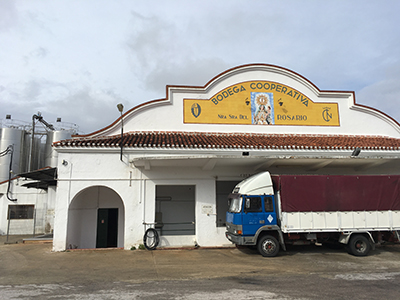
Called Catholic Agricultural Union when it was founded in 1917, Bodegas del Rosario adopted its current name in 1949. It was the first wine cooperative in the southeast of Spain. During its most active period it handled 11 million litres of wine, but this figure currently stands at around two million litres, 80% of which are bottled. The rest is sold in bulk.
This is the largest producer in a small region by Spanish standards. Their 150 active members manage 600 of the 1,300 hectares under vine in the Bullas appellation. Bodegas del Rosario is also behind over 90% of the region's exports. The US, Japan, Russia and China are their main markets in a portfolio that comprises 32 countries. In Spain, the wines are mainly sold locally.
The building retains all the charm of old cooperatives. Many of the old cement tanks are no longer in use, but their mosaic coating and floral decorations add charm to the premises. With such ample facilities, the cooperative devotes a room exclusively to wines meant to age in barrel (just like the separate, state-of-the-art facilities built by many leading producers in Spain for their top wines). The wines of two external winemakers are stored in them. They have joined forces with Norrel Robertson MW (aka El Escocés Volante)to produce the structured and serious 3,000 Años that blends equal parts of Monastrell and Syrah (5,000 to 7,000 bottles, about €35) and, more recently, El Borde, an aromatic, expressive, fresh single-vineyard Monastrell. Natural wine producer Julia Casado is behind the fun, fragrant, light Ninja de las Uvas Garnacha(€13, around 4,000 bottles).
Bodegas del Rosario's flaship brand is called Las Reñas. It encompasses a wide range of wines, from young Monastrell in red and rosé versions to the premium red Selección which includes 25% Syrah in the blend and retails for €15 in Spain. Additionally, Las Reñas includes a young organic red (80% of the vineyards in Bullas are organically grown), a Crianza and the red Cuatro, a blend of indigenous Monastrell with Tempranillo, Syrah and Cabernet.
A step above, Niño de las Uvas takes its name from an old Roman sculpture found in the area. The range features a white, a rosé and a red –all of them are sold for around €7 in Spain. Aged for three to four months in barrels, Niño de las Uvas red is a great example of Monastrell’s freshness when grown at high elevation.
Most popular
NEWSLETTER
Join our community of Spanish wine lovers


